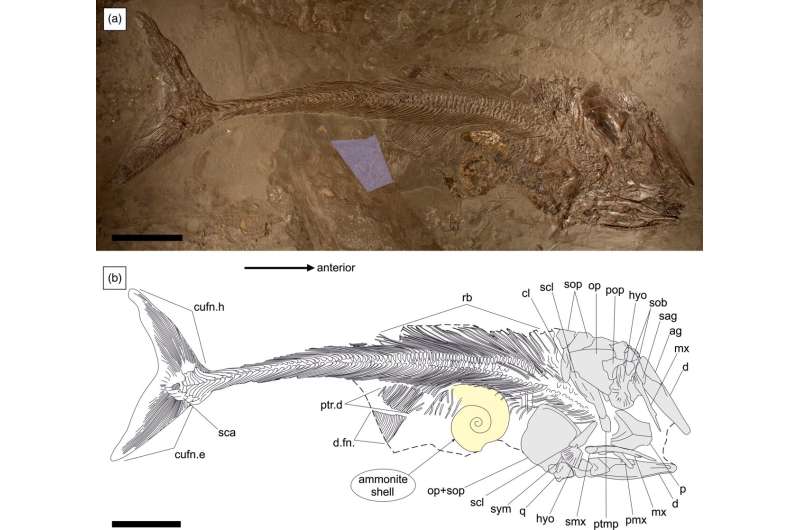August 3, 2023 report
This article has been reviewed according to Science X's editorial process and policies. Editors have highlighted the following attributes while ensuring the content's credibility:
fact-checked
trusted source
proofread
Jurassic era fish fossil found to have died from eating an overly large ammonite

A pair of paleontologists at Universität Hohenheim's Staatliches Museum für Naturkunde Stuttgart has found a fossilized Jurassic-era fish that appears to have died after swallowing an overly large ammonite. Samuel Cooper and Erin Maxwell report their study of the fossil in the journal Geological Magazine.
The fossil, Pachycormus macropterus, was found in Germany at a site called the Posidonienschiefer Formation. It has been dated back to between 174 and 182 million years ago, putting it in the early Jurassic. The fish was a type of actinopterygian, which are a type of bony, ray-finned fish—a modern example is the lionfish.
The researchers found its belly full of a variety of prey. They found evidence of soft-bodied mollusks that looked somewhat like modern cuttlefish or squid and other smaller fish. They also found a large ammonite conch approximately 10 centimeters across, which did not show signs of digestion, a sign that the fish had died soon after swallowing the shelled creature.
The ammonite, the researchers note, was much too big for the fish to digest. They suggest that it was likely misidentified by the fish or it somehow became stuck in its mouth for an unknown reason. At that point, the fish would have been unable to eject it from its mouth, leaving no choice but to swallow it. Once it did that, the ammonite's shell blocked passage to the intestine, resulting in either congestion or internal bleeding. Either would have killed the fish within hours.
Following its death, the researchers theorize, the fish sank to the bottom of the sea, where it was buried in the mud. Over time, it became entombed, along with the contents of its stomach (the researchers describe the condition of the ammonite as having excellent preservation), leaving evidence for scientist to discover millions of years later.
The find marks that first documented case of a fatal last meal found in an extinct pachycormid fish. The researchers suggest it also indicates that ammonites may have been more commonly eaten by bony fish during the Jurassic than previously thought.
More information: Samuel L. A. Cooper et al, Death by ammonite: fatal ingestion of an ammonoid shell by an Early Jurassic bony fish, Geological Magazine (2023). DOI: 10.1017/S0016756823000456
© 2023 Science X Network





















